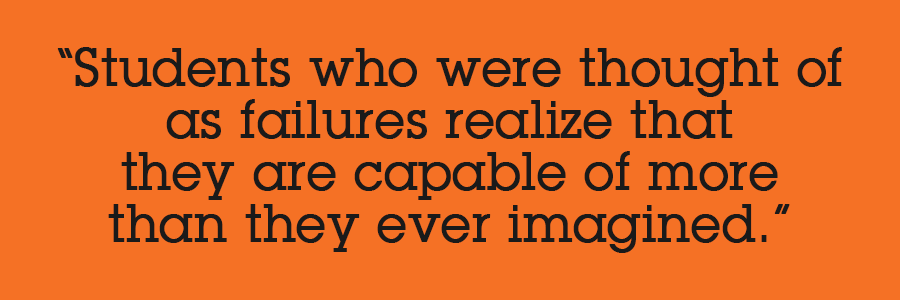Nine years ago, I and others working with transfer schools sat with the NYC Department of Education staff responsible for creating the first progress reports. They generously listened to feedback on how to assess transfer schools and let the progress report evolve over the years, drawing on many of these suggestions. This was not easy work.
Why wasn’t it easy? “Transfer” schools serve students who have struggled in other high schools for reasons ranging from gang problems to skill deficits. The best transfer schools re-engage these students in a family-like setting that is simultaneously more nurturing and more rigorous than they have experienced before. Students who were thought of as failures realize that they are capable of more than they ever imagined. To measure progress at these schools is tricky: a strong body of research shows that the constant messaging of struggle and failure these students have received for years only compounds the problem and the measures that failed them in prior schools are likely to miss their potential in new settings. In the years of advocacy that many inside and outside the Department of Education made for better measures of this population, some great steps were made: New York City’s progress reports were among the few in the nation that carefully adapted high school measures specifically for transfer schools and the City had done so with attention to how to gauge the progress that students who had struggled in the past are making.
After having years of public progress reports on transfer schools, for the last two years we have been without any public data on these schools. But there are some good and thoughtful reasons for this. There are some suggestions that my colleagues working with transfer schools had made for years that were never seriously considered until recently. One in particular is worth noting:
For six years of NYC Progress Reports, the City compared transfer school results to other transfer schools. Now remember: these are schools for whom the starting line is a mix of students whom they reach out to based on past failures; asking these schools to engage in a race against each other threatened to benefit those who change the starting line instead of those who make it to the finish. We repeatedly asked the City to instead compare individual students to comparative groups of students like them across the system: Take the 18-year-old who has never passed a class before and compare them to all the other 18-year-olds who had been in the same boat. This was repeatedly rejected in the past as too hard to do.
In the last two years, the response to this request changed. A close look at the new School Quality Snapshots the City just released reveals a new “Comparison Group” included for every school in the City. That is because now every student is compared to similar students in a way that makes for a more meaningful comparison, an improvement for the first time ever. The City worked for more than a year to make this metric a reality. The Comparison Group measure arose in part out of a series of suggestions from a group of transfer school principals that the Department of Education and Eskolta brought together.
Ironically, though, the new administration has not released Quality Snapshots for transfer schools for the last two years because they continue to try to iron out complications in the measures. Many of those serving this community find this frustrating and agree that more work needs to be done so that there can be some public comparison of data from these schools. Eskolta has begun work to create a map to enable educators to compare how individual students at their schools are faring in comparison to how they would have fared elsewhere, work that we hope will be the beginning of more meaningful comparisons.
At the same time, having had the opportunity to work with thousands of educators from New York transfer schools, I am convinced that we must continue to push for other changes that have not yet come.
Changes like looking at more than only graduation as the outcome of high school. While we must have high expectations for all students, we must also consider the fact that when considering the fates of students who would have likely dropped out otherwise, we should value other postsecondary outcomes that do not show up in a single diploma. Consider the student who finally re-engaged in learning at age 19 and gained valuable work habits and skills even though he could not mathematically earn the number of credits required to graduate by the legal age of 21. Shouldn’t we care about that student? Consider the student who not only graduated from high school but also paid her own way to get the finances to eventually go to college. Shouldn’t we value that outcome?
We should push for changes like keeping track of the level of engagement students have in high school and distinguishing data by these groups in order to better understand who our schools are taking in and at what point in their re-engagement they are falling off track.
We should push for changes like reducing emphasis on testing and comparative analysis and increasing emphasis on community-oriented accountability and cluster analysis that sees the child in relation to the community inside and outside the school.
Eskolta is continuing to work with the City and with transfer schools to have useful data and intelligent accountability systems that can help our schools, our educators, and our community members to understand progress, especially for the students that the rest of the system had once given up on. Getting the right measures in place and available for all transfer schools—measures that help to improve the situation and not simply compound it—is critical.

